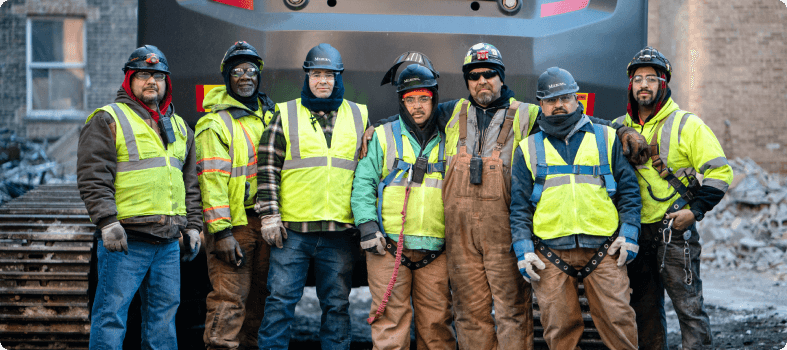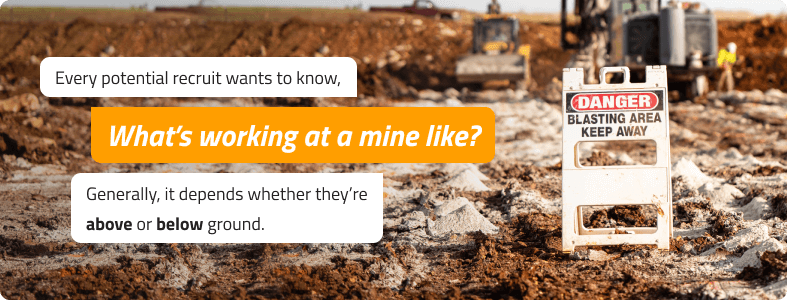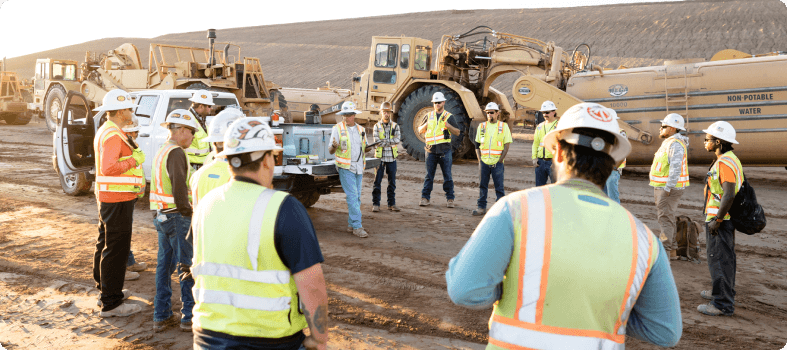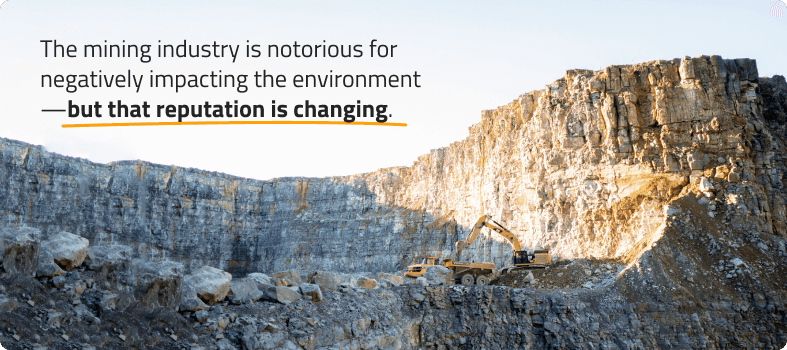Surface vs. Subsurface Mining
Written by Megan Hamilton
January 26, 2023
There are two main types of mining: surface and subsurface.
In this article, we're exploring their similarities and differences. We'll look at working conditions, career paths, safety, and more to help you better understand how to recruit the next generation of workers into this essential industry.
We asked experts John Scepaniak and Jonathan Hearrin to teach us about surface and subsurface mining. Let's meet them, and then we'll dive in.
Table of Contents
Meet John and Jonathan
What is surface vs. subsurface mining?
Surface mining extracts natural resources from the earth by first removing soil, rocks, and plants (called overburden) so miners can access the exposed mineral or metal deposit.
Subsurface miners tunnel underground to extract natural resources, leaving the landscape above the mine intact.
Mining methods
Surface and subsurface mining have existed for over 5,000 years, and they each serve a purpose.1 Surface mines extract matter that's closer to the earth's surface. Subsurface mining helps retrieve materials that are more abundant deeper inside the earth.2
Since all metals and minerals are different, there aren't one-size-fits-all surface or subsurface mining methods. Today's miners have numerous ways to extract resources.
Surface mining methods
|
Open-pit |
Miners drill and blast ore from the ground, leaving large, deep pits. These are the most common, longest-lasting surface mines. Scepaniak uses open-pit mines to extract sand, gravel, granite, quartzite, limestone, and other material. |
|
High-wall |
Miners drill into an exposed cliff or the side of an open-pit mine to extract resources. They use remote-controlled machinery, so they stay a safe distance from the face. |
|
Strip |
Miners remove overburden to extract shallow ore deposits. Some strip mines follow straight lines, while contour mines follow the landscape. |
|
Mountaintop removal |
Miners blast or excavate the top of a mountain to access the resources inside. |
|
Dredging |
Dredging pans large bodies of water for valuable metals, such as gold. |
Subsurface mining methods
Subsurface mines typically use stoping or caving methods.
Stoping extracts wide, horizontal deposits called seams or narrow deposits called veins. It leaves empty rooms or tunnels behind.
|
Room-and-pillar mining |
Miners extract most ore from rooms. However, they leave pillars of ore intact to hold up the mine's roof. This low-cost method is common for coal mines like the one where Jonathan worked. |
|
Cut-and-fill mining |
Miners cut beneath veins, remove the ore in slices, and refill the vein with waste to stabilize the mine. This works best for irregularly-shaped ore deposits. |
|
Shrinkage stoping |
Miners break the ore at the bottom of a vertical deposit. They then use it as a platform to reach the ore above. This requires strong surrounding rock, so the stope doesn't collapse. |
|
Sublevel stoping |
Also called long-hole, open, or blasthole stoping, this method blasts steep, narrow ore veins out of strong surrounding rock. Miners may backfill some areas. |
Caving is an underground mining method that allows controlled roof or wall collapses.
|
Longwall mining |
Longwall is a highly mechanized, precise way to extract long, ultra-thin ore strips by running machines along the vein. Unlike other caving methods, miners may add some support. |
|
Block caving |
Miners cut below the deposit. They let the ore and surrounding rock break with its own weight, then extract the pieces. This works best for long, steep, low-grade ore deposits. |
|
Sublevel caving |
Miners start atop a steep ore deposit, then move down a series of sublevels. The walls naturally collapse, and they remove that waste with the ore from the next sublevel and separate the material outside the mine. |
Choosing a mining method
When engineers and prospectors decide how to harvest natural resources, John says their biggest question is, "What's in the way?"
"There's no set criteria like, 'When there's eight feet of overburden, we strip mine,'" he explains. Rather, companies analyze extraction costs, potential yield, and potential profit for various mining methods.
Underground mine operators also do cost-benefit analyses, but they have to factor in whether the surrounding rock is strong enough for stoping or whether caving is safer.
The type and amount of ore also matter. For coal, Jonathan says, "Surface mining is usually a number six coal seam. Underground, you're looking more at number nine and number eleven seams." The higher the number, the thicker the coal seam.
He adds that many coal mines are subsurface because coal is more abundant underground—whereas other ore types may be more abundant closer to the surface.
Removing materials from mines
At surface mines, machines carry raw materials either to a conveyor belt that feeds into an onsite prep plant or to haul trucks for off-site prep.
Underground, miner operators typically load ore onto shuttle cars that transport it to a feeder. The feeder pours onto a conveyor belt, which carries the ore to the prep plant. "The farther you go, you move the feeder and beltline closer to you. That's called advancing," Jonathan teaches. The beltline at his mine was almost 80 miles long.
The prep plant brushes and washes the raw material. Then, it's loaded onto trucks. Scepaniak's trucks deliver products directly to clients. At Jonathan's mine, trucks hauled coal to river barges that delivered it to clients.
Production time
Generally, surface mines can produce faster than subsurface mines.
That's because as subsurface miners go deeper underground, they take longer to get to the face—which is the active mining area—and transport ore out of the mine. They also have to stop regularly to ventilate and shore up the mine.
Surface mine operators can produce nearly constantly—with little travel time and few stoppages.
Mining jobs and crew sizes
Many young people today would love to build a career in the Dirt World; they just don't know how. If that's you, hang tight. We'll teach you about some of the jobs available in this essential and valuable industry.
Surface mining jobs
Surface mines typically operate with very small crews. These are the main jobs:
- Plant operators also called groundsmen, run the rock crusher and prep plant. They're typically experienced, workers and foremen.
- Machine operators run the mining equipment. "They tend to be newer workers or veterans who don't want to lead,"says John.
- Truck drivers deliver material to off-site prep plants or clients.
- Electricians and mechanics keep the prep plant and machines running. Many small companies like Scepaniak outsource these jobs.
Currently, Scepaniak can operate a mine with just four to six employees.
Subsurface mining jobs
Subsurface mines also have electricians and mechanics who often work when the mine isn't producing. (That's when the mining area and machines are accessible.) Truck drivers and plant operators work when miners do.
Subsurface mines also have several unique jobs:
- Roof bolter (or pinner) is most miners' first job. "It's very hot and dangerous. You drill holes in an unsupported roof and put pins in it to hold it up," Jonathan says.
- Hostlers set up curtains to ventilate the mine and train on the remote-controlled continuous miner. Jonathan explains, "You help the guy running the miner, and on his lunch breaks, you learn how to run it." A super unit has two hostlers.
- Continuous miner operators run the machine that extracts the ore. They must be trustworthy crew members who are willing to work hard.
- Shuttle car drivers take ore from the miner to the beltline. In Jonathan's mine, female miners often drove shuttle cars. "Maybe 8-10 women worked on our crew of 120," he says.
Want to learn more about women in the Dirt World? Check out these incredible stories of women who work in this industry.
Preparing for work
At surface mines, John says,"Crews roll up onsite, do machine walkarounds, and do any plant maintenance that's needed. It's similar to an open-air construction job."
Underground miners stow their belongings aboveground and put on their headlamp, battery pack, and rescuer—a heavy, palm-sized rescue inhaler that can provide oxygen for about 10 hours.
From there, they may ride into the mine on a transport vehicle called a mantrip. Or at shaft mines, they use an elevator that fits 30-40 people. "We called it The Cage, because it's expanded metal. You can see the bottom, but it's just a little bitty light," Jonathan recalls.
After traveling down the shaft, mantrips carry workers to the face, typically taking 5-15 minutes. However, Jonathan adds, "Some units are farther away. I was on Unit Six; it took 45 minutes to get there."
Shifts and lifestyle

Miners generally work long hours, up to six days a week. Scepaniak runs 12-hour day shifts and 12-hour night shifts five days a week. At Jonathan's underground mine, "We did almost 10 hours daily. We ran coal five or six days a week."
Jonathan notes, "If you wanted to work on days they weren't running coal, you could. You write your own check."That can make mining a financially promising career for people willing to work hard to maximize their earning potential.
Shift work can pose challenges, especially for underground miners. As Jonathan points out: "On winter day shifts, you go into the mine when it's dark, work in darkness all day, and come out when it's dark. You can go five days and not see daylight. It's depressing."
Fortunately, many leaders are doing a better job recognizing how this lifestyle can impact workers and making mental health resources available.
Working conditions

Aboveground
Surface mines are loud and dusty, but they're relatively comfortable. According to John, "You're not going into confined spaces. You're often in an air-conditioned machine cab with a radio, doing walkarounds for plant upkeep and cleanliness, or in an air-conditioned control room."
Many miners enjoy working in large, open-air spaces and find that it benefits their mental well-being. Plant operators and haul truck drivers who work for subsurface mining companies enjoy these benefits, too.
Underground
Make no bones about it: working underground is tough.
Thin ore deposits create cramped working conditions. Jonathan explains, "A number eleven coal seam is tall enough you can stand up in it. A number nine—where I worked—is 52-60 inches tall." He could stand up straight if a small cave-in created some headspace.
It's also hot: ventilation blows air and methane away from the face, but it's more for safety than cooling the mine.
Underground miners can expect dampness as the continuous miner sprays water to dissipate dust and methane. Standing water can be an issue, too. Jonathan recalls, "Some places were dry. Some places, water was up to our knees." It's important to wear the proper personal protective gear to make sure you stay safe and dry.
We won't sugarcoat it: these conditions underground can be tough, and it's up to you to decide whether you're up for the challenge. If you are, the next step is some serious safety training.
Worker safety
Jobsite safety is a big deal in mining. Last year, 3,421 miners got injured so badly that they needed time off work, and 37 more died in workplace accidents.3,4 Injuries most often came from material mishandling, slips and falls, and machine-related accidents.5
Mining companies must take steps to keep people safe on the job. That starts with recognizing hazards and looking for ways to mitigate them.

Aboveground hazards
John categorizes the types of jobsite hazards as immediate or chronic.
Immediate hazards can cause instant injury or fatality—like machines hitting pickup trucks. "Rather than car-on-car collisions, it's machine-on-small-vehicle obliteration," he says. "Situational awareness is key to preventing accidents like this."
Factory-style equipment poses another hazard. "It does what it's designed to do whether your finger is there or not,"John observes. Lock-out tag-out mechanisms and machine guards help prevent accidents here.
Chronic hazards have long-term effects, especially on hearing and respiration. Breathing dust long-term can cause silicosis—when silicone particles permanently damage miners' lungs.
"We mitigate fugitive dust emissions with water sprays. We also have respirators any time the water isn't doing the job," John says, then adds, "but it's up to workers to use PPE. You can't put earplugs in for them."
Underground hazards
Subsurface mining is more dangerous. Subsurface miners have told John, "If something goes catastrophically wrong, I won't have to worry about it the next day [because I won't live]."
Jonathan agrees wholeheartedly: "You've got to be fearless to work underground. Any time you're doing anything underground, there's danger."
Immediate underground hazards include:
- Cave-ins
- Gas leaks and explosions
- Machine-related accidents
- Floods
Jonathan's father and grandfather taught him an important lesson about flooding: "When a pinner drills into the roof and water comes out, you're in a bad situation. That means everything above you is water. If you keep drilling, you will flood the mine."
Chronic hazards include:
- Hearing loss
- Respiratory diseases
- Arthritis from stooping and bending
- Poor mental health and increased suicide risk6,7
As with surface mines, subsurface miners and their bosses can mitigate both immediate and chronic risks. Even seemingly simple things—like wearing PPE and understanding the mental health risks mine workers face—go a long way.
Making the industry safer
1. Acknowledge the risks
You need to know what you're getting into before you start. Otherwise, you may become disillusioned and quit, increasing turnover in an industry that's already struggling with a people problem.
Plus, ignoring hazards sets people up for disaster. Mining has inherent risks—so why take unnecessary chances? Leaders and crew members alike are responsible for making the mine site as safe as possible so every crew member can get home to their loved ones.
Jonathan says, "Underground, one mistake could kill not only you but a mass amount of people."That's why miners must always be aware of what they're doing, what's happening around them, and how they can help others.
If you want employees to take that level of ownership, you have to teach them how. This brings us to . . .
2. Get training
Employers must train new hires on safety—even if that means they don't do any work for their first few days. Now, we know you want to get in there and get to work. But in the Dirt World, you have to slow down to speed up. In other words, you must first take time to get proper training. Lives depend on it.
Later, new hires can level up their skills through mentorship programs and ongoing training.
By the way, experienced employees need recurring safety training, too. Repetition helps them retain and practice good safety habits.
Remember, safety training isn't just a box you check to please the MSHA gods. It's a real, life-saving tool you needs. Plus, it increases productivity by reducing mistakes, accidents, and machine downtime.
So don't skip safety training. Don't try to get around it. Don't take any shortcut that endangers you or anyone around you.
For leaders: Follow these nine tips to train your crew better.
Environmental impact

Surface mining's impact
People react strongly to surface mining "because it's visual. You can see it," John says.
Surface mining can affect the environment via:
- Water and air pollution
- Loss of vegetation and topsoil
- Large holes from open-pit and high-wall mining operations
However, those effects are not as severe or permanent as you might think. John teaches that surface mines are a temporary use for the landscape: "After we harvest that vital natural resource, we can reclaim that area with plants, wildlife, developments, whatever you want."
Subsurface mining's impact
Environmental impacts from operational and disused subsurface mines can include:
- Air pollution
- Water contamination
- Gas leaks (even after mining stops)
- Unsafe tunnels or rooms that could harm curious people or animals
- Subsidence (when the ground above the mine sinks, creating instability)
Jonathan adds that sometimes using the final product pollutes more than extracting the raw material: "Obviously, burning coal is bad for the environment, but this is what we have. There's an abundance of coal. Presently clean energy—which is good—can't keep up with demand as much as coal can."
Many subsurface mining companies (coal or otherwise) are working to make their products cleaner and reduce their environmental impact.
Repurposing old mines
The U.S. has an estimated half a million disused mines, so it's worth asking, "What are we going to do with all those holes in the ground?"8
Many mine operators are putting serious attention and money into reclamation these days. "The industry is shifting, and that's good. I try to teach all our clients about our ability to restore areas afterward," John says.
For example, Scepaniak works with local quarry operators in Minnesota to recycle granite waste into high-quality road-building material. Likewise, subsurface mine operators are repurposing disused underground mines into cool things like:
- Farms
- Churches
- Storage facilities
- Gravity-based power plants
- Adventure parks and tourist attractions
What to know when you're considering a career mining
Jonathan is very candid about not every mining job is for every person.
He recalls, "I knew a guy who was a big stud growing up—star quarterback and all that. He got married and had a baby on the way, so the mine hired him to work on my unit. They asked me to take him into the mine on his first day.
"We got in The Cage, and he started shaking like a leaf. As soon as we started going down, he got on his knees trying to hang onto everything. He kept saying, 'Stop! Take me back up!' but I couldn't. Once you push that button, you're going all the way down. He had to ride it out to the bottom. Then I took him right back up, and he quit that day."
Now, we told you that story to tell you this: not every mining job is for everyone . . . but every mining job is for someone. The question is, how do you know if it's for you?
Learn from others
The best way to find out the good, bad, and ugly of any industry is to see what others like and dislike about it. Why are they excited about what they do? Why do they come to work each day?
Some miners love running cool machines, working on a great crew, moving earth and rock, or tackling the challenge of working underground.
You can find their stories on company websites and social media. For example, Scepaniak spotlights crew members like Ethan and Ben. These guys shared why they love surface mining and working for their company on YouTube. That's awesome!
When you hear honest stories from men and women who already work in the industry, it's easier to see yourself in it, too.













